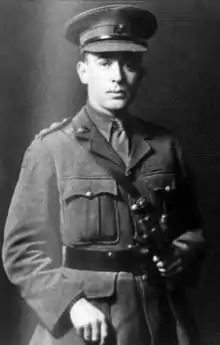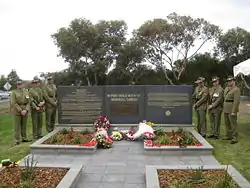Mick Moon
Rupert Theo Vance "Mick" Moon, VC (14 August 1892 – 28 February 1986) was an Australian recipient of the Victoria Cross, the highest award for gallantry in the face of the enemy that can be awarded to British and Commonwealth forces.
Rupert Vance "Mick" Moon | |
|---|---|
 Rupert Moon | |
| Nickname(s) | "Mick" |
| Born | 14 August 1892 Bacchus Marsh, Victoria |
| Died | 28 February 1986 (aged 93) Barwon Heads, Victoria |
| Buried | Mount Duneed Cemetery |
| Allegiance | Australia |
| Service/ | Australian Army |
| Years of service | 1914–19 1942–45 |
| Rank | Captain |
| Unit | 58th Battalion |
| Battles/wars | First World War Second World War |
| Awards | Victoria Cross |
| Spouse(s) | Susan Alison May Vincent |
Early life and First World War
Moon was born at Bacchus Marsh, Victoria, on 14 August 1892. He was the son of Mr and Mrs Arthur Moon of Kinaird, Toorak, Victoria.[1] When he left school he worked for the National Bank of Australasia and was at the Maffra branch when World War I began.[2] He was 24 years old, and a lieutenant in the 58th Battalion, Australian Imperial Force during the First World War when the following deed took place for which he was awarded the VC.
On 12 May 1917 near Bullecourt, France, Lieutenant Moon's immediate objective was a position in advance of a hostile trench, and then against the trench itself, after the capture of which it was intended that his men should co-operate in a further assault. Although wounded in the initial advance, he reached the first objective, but was again wounded in the assault on the trench. He nevertheless continued to inspire and encourage his men and captured the trench, but was again wounded when consolidating the position. It was not until he was severely wounded for a fourth time that he agreed to retire from the fight.[3] He later achieved the rank of captain.
His Victoria Cross which he received from King George V at an investiture at Buckingham Palace[4] is displayed at the Australian War Memorial.[5]
Post-war and later life
After he returned from the war he resumed working for the National Bank in Geelong, a position he held until he took up a senior position with Dennys Lascelles Ltd.[2] On 17 December 1931 he married Sammy Vincent at St George's Church Geelong.[6]
He lived at Calder Park, Mount Duneed from 1954 to 1978.[7][8] He died at his home at Barwon Heads on 28 February 1986 and was buried in the Anglican section of Mount Duneed Cemetery.[9]
Legacy

In 1918 an avenue of honour was created linking Bacchus Marsh to the Western Highway. Constructed from elm trees, the avenue was planted to commemorate soldiers from Bacchus Marsh who served in the First World War. The 164th tree in the avenue was planted and dedicated to Moon.[10] In recent years, Moon Reserve was unveiled at the beginning of the Avenue of Honour in honour of Rupert Vance Moon. In 2010, the Avenue of Honour was nominated to be placed on the National Heritage list.[11]
On 12 May 2008, the Rupert Vance Moon V.C. Memorial Garden was unveiled at the Mount Duneed Cemetery, with a large crowd in attendance, including Moon's descendants, representatives from the Returned and Services League of Australia, and past and present soldiers.
Notes
- VCs of the First World War Arras and Messines 1917 by Gerald Gliddon
- Western Mail (Perth, WA) 4 February 1937 page 11
- "No. 30130". The London Gazette (Supplement). 12 June 1917. p. 5865.
- Southern Cross (Adelaide, SA) 15 August 1947 page 7
- The Canberra Times 14 April 1986 page 16
- Table Talk (Melbourne) 24 December 1931
- Mount Duneed Primary School Centenary 1878 – 1978
- Victorian Heritage Database – Rupert Vance Moon Memorial Garden report
- Salmon 2012.
- "Bacchus Marsh Avenue Of Honour - People - Rupert Theo Vance Moon VC". avenueofhonour.org.au. Retrieved 3 October 2015.
- "A Matter Of Honour". Archived from the original on 5 November 2012. Retrieved 30 May 2010.
References
- Salmon, J.R. (2012). "Moon, Rupert Theo Vance (Mick) (1892–1986)". Australian Dictionary of Biography. Volume 18. Carlton, Victoria: Melbourne University Press. ISBN 9780522861310.